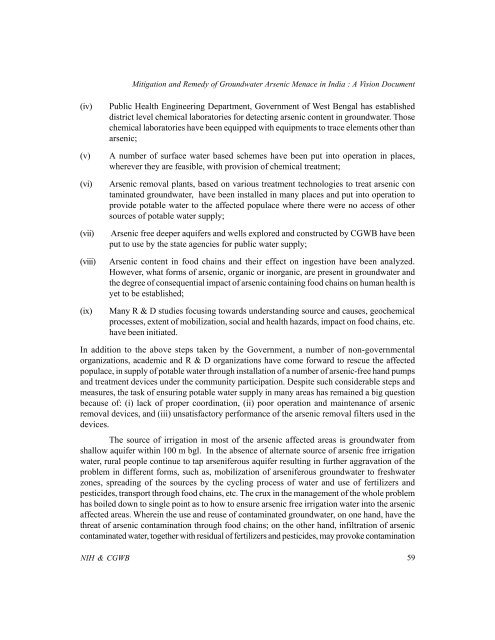Mitigation and Remedy of Groundwater Arsenic Menace in India
Mitigation and Remedy of Groundwater Arsenic Menace in India
Mitigation and Remedy of Groundwater Arsenic Menace in India
Create successful ePaper yourself
Turn your PDF publications into a flip-book with our unique Google optimized e-Paper software.
<strong>Mitigation</strong> <strong>and</strong> <strong>Remedy</strong> <strong>of</strong> <strong>Groundwater</strong> <strong>Arsenic</strong> <strong>Menace</strong> <strong>in</strong> <strong>India</strong> : A Vision Document(iv)(v)(vi)Public Health Eng<strong>in</strong>eer<strong>in</strong>g Department, Government <strong>of</strong> West Bengal has establisheddistrict level chemical laboratories for detect<strong>in</strong>g arsenic content <strong>in</strong> groundwater. Thosechemical laboratories have been equipped with equipments to trace elements other thanarsenic;A number <strong>of</strong> surface water based schemes have been put <strong>in</strong>to operation <strong>in</strong> places,wherever they are feasible, with provision <strong>of</strong> chemical treatment;<strong>Arsenic</strong> removal plants, based on various treatment technologies to treat arsenic contam<strong>in</strong>ated groundwater, have been <strong>in</strong>stalled <strong>in</strong> many places <strong>and</strong> put <strong>in</strong>to operation toprovide potable water to the affected populace where there were no access <strong>of</strong> othersources <strong>of</strong> potable water supply;(vii) <strong>Arsenic</strong> free deeper aquifers <strong>and</strong> wells explored <strong>and</strong> constructed by CGWB have beenput to use by the state agencies for public water supply;(viii)(ix)<strong>Arsenic</strong> content <strong>in</strong> food cha<strong>in</strong>s <strong>and</strong> their effect on <strong>in</strong>gestion have been analyzed.However, what forms <strong>of</strong> arsenic, organic or <strong>in</strong>organic, are present <strong>in</strong> groundwater <strong>and</strong>the degree <strong>of</strong> consequential impact <strong>of</strong> arsenic conta<strong>in</strong><strong>in</strong>g food cha<strong>in</strong>s on human health isyet to be established;Many R & D studies focus<strong>in</strong>g towards underst<strong>and</strong><strong>in</strong>g source <strong>and</strong> causes, geochemicalprocesses, extent <strong>of</strong> mobilization, social <strong>and</strong> health hazards, impact on food cha<strong>in</strong>s, etc.have been <strong>in</strong>itiated.In addition to the above steps taken by the Government, a number <strong>of</strong> non-governmentalorganizations, academic <strong>and</strong> R & D organizations have come forward to rescue the affectedpopulace, <strong>in</strong> supply <strong>of</strong> potable water through <strong>in</strong>stallation <strong>of</strong> a number <strong>of</strong> arsenic-free h<strong>and</strong> pumps<strong>and</strong> treatment devices under the community participation. Despite such considerable steps <strong>and</strong>measures, the task <strong>of</strong> ensur<strong>in</strong>g potable water supply <strong>in</strong> many areas has rema<strong>in</strong>ed a big questionbecause <strong>of</strong>: (i) lack <strong>of</strong> proper coord<strong>in</strong>ation, (ii) poor operation <strong>and</strong> ma<strong>in</strong>tenance <strong>of</strong> arsenicremoval devices, <strong>and</strong> (iii) unsatisfactory performance <strong>of</strong> the arsenic removal filters used <strong>in</strong> thedevices.The source <strong>of</strong> irrigation <strong>in</strong> most <strong>of</strong> the arsenic affected areas is groundwater fromshallow aquifer with<strong>in</strong> 100 m bgl. In the absence <strong>of</strong> alternate source <strong>of</strong> arsenic free irrigationwater, rural people cont<strong>in</strong>ue to tap arseniferous aquifer result<strong>in</strong>g <strong>in</strong> further aggravation <strong>of</strong> theproblem <strong>in</strong> different forms, such as, mobilization <strong>of</strong> arseniferous groundwater to freshwaterzones, spread<strong>in</strong>g <strong>of</strong> the sources by the cycl<strong>in</strong>g process <strong>of</strong> water <strong>and</strong> use <strong>of</strong> fertilizers <strong>and</strong>pesticides, transport through food cha<strong>in</strong>s, etc. The crux <strong>in</strong> the management <strong>of</strong> the whole problemhas boiled down to s<strong>in</strong>gle po<strong>in</strong>t as to how to ensure arsenic free irrigation water <strong>in</strong>to the arsenicaffected areas. Where<strong>in</strong> the use <strong>and</strong> reuse <strong>of</strong> contam<strong>in</strong>ated groundwater, on one h<strong>and</strong>, have thethreat <strong>of</strong> arsenic contam<strong>in</strong>ation through food cha<strong>in</strong>s; on the other h<strong>and</strong>, <strong>in</strong>filtration <strong>of</strong> arseniccontam<strong>in</strong>ated water, together with residual <strong>of</strong> fertilizers <strong>and</strong> pesticides, may provoke contam<strong>in</strong>ationNIH & CGWB 59




